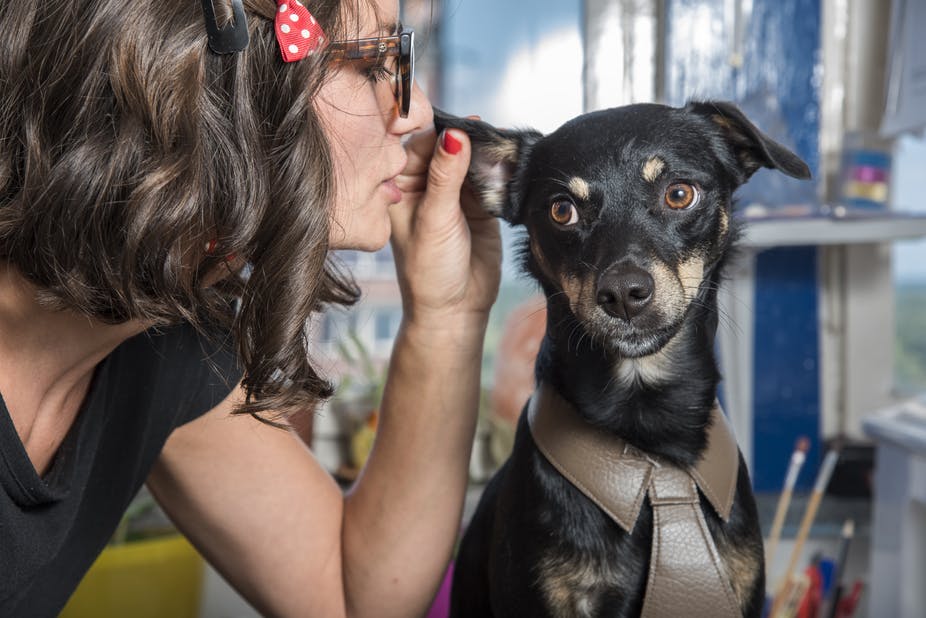Dogs are special. Every dog owner knows that. And most dog owners feel their dog understands every word they say and every move they make. Research over the last two decades shows dogs really can understand human communication in ways no other species can. But a new study confirms that if you want to train your new puppy, you should be speaking to it in a certain way to maximise the chances that it follows what you’re saying.
There is already quite a lot of research evidence showing that the way we communicate to dogs is different from the way we communicate to other humans. When we talk to dogs, we use what is called “dog directed speech”. This means we change the structure of our sentences, shortening and simplifying them. We also tend to speak with a higher pitch in our voices. We also do this when we are not sure we are understood or when talking to very young infants.
A new study has shown we use an even higher pitch when talking to puppies, and that this tactic really does help the animals to pay attention more. The research, published in the journal Proceedings of the Royal Society B, showed that talking to puppies using dog-directed speech makes them react and attend more to their human instructor than regular speech.
To test this, the researchers use so-called “play back” experiments. They made recordings of humans repeating the phrase “Hi! Hello cutie! Who’s a good boy? Come here! Good boy! Yes! Come here sweetie pie! What a good boy!”. Each time, the speaker was asked to look at photos of either puppies, adult dogs, old dogs or at no photos. Analysing the recordings showed the volunteers did change how they spoke to different aged dogs.
The researchers then played the recordings back to several puppies and adult dogs and recorded the animals’ behaviour in response. They found the puppies responded more strongly to the recordings made while the speakers looked at pictures of dogs (the dog-directed speech).
The study didn’t find the same effect applied for adult dogs. But other studies that recorded dogs’ reactions to the human voice in live interactions, including work I have done, have suggested dog-directed speech can be useful for communicating with canines of any age.
Following the point
It’s also been proven (and most dog-owners will tell you) that we can communicate with dogs through physical gestures. From puppy age on, dogs respond to human gestures, such as pointing, in ways other species can not. The test is very simple. Place two identical cups covering small pieces of food in front of your dog, making sure it cannot see the food and doesn’t have any information about the contents of the cups. Now point to one of the two cups while establishing eye contact with your dog. Your dog will follow your gesture to the cup you pointed to and explore the cup, expecting to find something underneath.
This is because your dog understands that your action is an attempt to communicate. This is fascinating because not even human’s closest living relatives, chimpanzees, seem to understand that humans communicate intent in this situation. Nor do wolves – dog’s closest living relatives – even if they are raised like dogs in a human environment.
This has led to the idea that dogs’ skills and behaviours in this area are actually adaptations to the human environment. That means living in close contact with humans for over 30,000 years has led dogs to evolve communication skills that are effectively equal to those of human children.
But there are significant differences in how dogs understand our communication and how children do. The theory is that dogs, unlike children, view human pointing as some kind of mild command, telling them where to go, rather than a way of transferring information. When you point for a child, on the other hand, they will think you are informing them about something.
This ability of dogs to recognise “spatial directives” would be the perfect adaptation to life with humans. For example, dogs have been used for thousands of years as a kind of “social tool” to help with herding and hunting, when they had to be guided over a great distance by gestural instructions. The latest research affirms the idea that not only have dogs developed an ability to recognise gestures but also a special sensitivity to the human voice that helps them identify when they need to respond to what’s being said.
Downvoting a post can decrease pending rewards and make it less visible. Common reasons:
Submit
Hi! I am a robot. I just upvoted you! I found similar content that readers might be interested in:
https://qz.com/894001/theres-a-wrong-and-a-right-way-to-talk-to-your-dog-according-to-science/
Downvoting a post can decrease pending rewards and make it less visible. Common reasons:
Submit
Congratulations @gedoni! You received a personal award!
You can view your badges on your Steem Board and compare to others on the Steem Ranking
Do not miss the last post from @steemitboard:
Vote for @Steemitboard as a witness to get one more award and increased upvotes!
Downvoting a post can decrease pending rewards and make it less visible. Common reasons:
Submit
Congratulations @gedoni! You have completed some achievement on Steemit and have been rewarded with new badge(s) :
Click on any badge to view your own Board of Honor on SteemitBoard.
For more information about SteemitBoard, click here
If you no longer want to receive notifications, reply to this comment with the word
STOPDownvoting a post can decrease pending rewards and make it less visible. Common reasons:
Submit
Congratulations @gedoni! You received a personal award!
Click here to view your Board
Downvoting a post can decrease pending rewards and make it less visible. Common reasons:
Submit